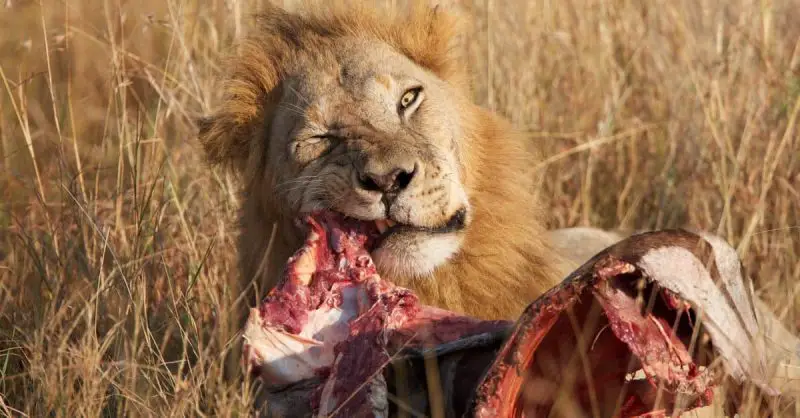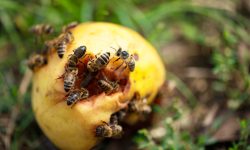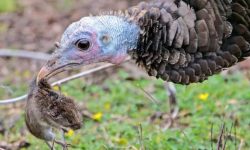Lions, often called the kings of the jungle, are among the most powerful and iconic predators on Earth. These magnificent big cats depend entirely on meat to survive, thrive, and sustain their dominance in the wild. Understanding what lions eat helps reveal how they maintain their strength, how they interact with the ecosystem, and why prey availability is so crucial for their survival.
In this article, we’ll dive deep into the diet of lions — how they hunt, what kinds of prey they prefer, and a detailed look at 20 specific foods that power these apex predators both in the wild and in captivity.
Understanding a Lion’s Diet

Why Diet Matters
Lions are obligate carnivores, meaning they rely completely on meat. Their muscular build, sharp claws, and strong jaws are designed for tearing flesh and crushing bones. To maintain such power, they need a diet rich in protein, fats, and vital nutrients. Without enough food, lions lose muscle mass, become weak, and are less capable of defending their pride or hunting efficiently.
How Lions Hunt
In most prides, lionesses do the hunting, working together in coordinated groups to stalk and ambush prey. Males usually defend territory and join the feast once the kill is made. Lions prefer hunting large herbivores since a single kill can feed an entire pride for days. However, they are also opportunistic — meaning they will eat almost any animal they can overpower or scavenge when necessary.
20 Foods That Power the King of the Jungle
1. Zebras
Zebras are one of the lion’s primary food sources in the African plains. Their size and abundance make them perfect prey for coordinated lion hunts. A single zebra can feed an entire pride for several days, supplying vital protein and fat.
Hunting zebras is a strategic challenge. Lions often rely on ambush tactics, using tall grass for cover and striking when the herd is distracted. This teamwork demonstrates the incredible coordination and patience of the pride.
2. Wildebeest
Wildebeest are another favorite prey for lions, particularly during the Great Migration. These large animals move in massive herds, making them easy to locate and track. The abundance of wildebeest ensures that lions rarely go hungry during migration seasons.
Their meat is rich in energy, helping lions build muscle and recover from strenuous hunts. A successful wildebeest kill can sustain multiple adults and cubs, highlighting its importance in the lion’s yearly diet.
3. Cape Buffalo
Cape buffalo are among the most dangerous animals that lions hunt. They are strong, aggressive, and travel in herds that defend one another. However, when lions manage to bring one down, the nutritional reward is enormous.
Buffalo meat is dense with fat and iron, fueling lions with long-lasting energy. These risky hunts often involve the entire pride, demonstrating their teamwork and strength as top predators.
4. Antelopes
Antelopes are smaller than buffalo or wildebeest but far more common. Species such as impalas, gazelles, and kudus are frequent targets for lions because they’re easier to catch and highly nutritious. Their lean meat provides essential proteins for muscle maintenance.
Lions prefer hunting antelopes in open grasslands where visibility and speed matter. The quick chases and short bursts of energy make these hunts exciting and efficient, especially for young lions learning to hunt.
5. Giraffes
Although giraffes tower over most animals, they occasionally fall victim to lions, especially if they are young, injured, or isolated. Taking down a giraffe is a dangerous mission that requires multiple lions to coordinate and attack from behind to avoid lethal kicks.
When successful, a giraffe kill provides an enormous meal. The meat sustains a pride for days, supplying vital nutrients needed for growth and reproduction. Such rare hunts show the courage and persistence of lions when large prey is scarce.
6. Warthogs
Warthogs are common across African savannahs and are often targeted by lions for their accessibility. These sturdy animals live in burrows, and lions usually ambush them as they emerge in the early morning or late afternoon.
Their meat is fatty and flavorful, providing energy during dry seasons. Warthogs play a key role in maintaining the lion’s diet variety, particularly when large herds of antelope move away.
7. Bushpigs and Wild Boars
In forested or mixed habitats, lions often hunt bushpigs and wild boars. These animals are aggressive and fast, but their moderate size makes them manageable prey for smaller prides or solitary males.
Bushpig meat provides a good balance of fat and protein, ideal for lions needing to replenish strength. The hunt itself also offers a challenge, helping maintain the lion’s sharp instincts and physical fitness.
8. Deer and Sambar (for Asiatic Lions)
Asiatic lions, found only in India’s Gir Forest, feed mainly on deer species such as chital, sambar, and nilgai. These herbivores are abundant and form the foundation of the lion’s regional diet.
The hunting method mirrors that of African lions — stealth, patience, and teamwork. This adaptation shows how lions thrive in diverse habitats while maintaining their carnivorous feeding behavior.
9. Livestock
When wild prey becomes scarce, lions may attack livestock such as cattle, goats, and sheep. This shift in diet occurs mainly in areas where human settlements overlap with lion territories.
Although livestock provides easy nutrition, it often leads to conflict with local farmers. Conservation programs work to prevent such encounters by restoring natural prey populations and protecting both lions and communities.
10. Small Mammals
Lions are opportunistic feeders and will hunt small mammals like hares, mongooses, and rodents when larger prey is unavailable. These smaller meals help sustain energy levels during periods of scarcity.
Though less substantial, small mammals provide quick nutrition with minimal effort. Young or inexperienced lions often rely on such prey to practice their hunting techniques safely.
11. Birds
Birds form a minor but interesting part of the lion’s diet. Ground-dwelling species such as ostriches or guinea fowl may fall prey to lions, particularly when nesting or guarding chicks.
While bird meat doesn’t provide the same volume as large mammals, it offers a lean source of protein and helps lions diversify their food intake. Such opportunistic hunts also reveal the lion’s adaptability.
12. Fish and Aquatic Prey
Although rare, lions have been observed catching fish and aquatic animals near shrinking waterholes. These opportunistic hunts usually occur during droughts when land prey becomes difficult to find.
Such behavior shows the lion’s flexibility and intelligence. They can adapt their hunting techniques to different environments and still meet their nutritional needs even in harsh conditions.
13. Carrion
Lions are not just hunters — they are also capable scavengers. They will eat carcasses left by other predators, including hyenas or leopards, when the opportunity arises. Scavenging helps lions conserve energy and survive during lean seasons.
Even though scavenged meat might be partially decomposed, it still provides essential nutrients. This ability to feed opportunistically gives lions an edge in competitive ecosystems.
14. Juvenile Herbivores
Young animals such as elephant calves, baby giraffes, or young buffalo are frequent targets for lions. These juveniles are easier to catch, and their meat is soft and nutrient-dense.
Lions often take advantage of moments when the young stray too far from adults. Such hunts are critical during dry seasons when full-grown prey are harder to overpower.
15. Reptiles
Occasionally, lions have been observed attacking large reptiles like crocodiles or monitor lizards. These hunts are risky, but they showcase the lion’s boldness and opportunistic nature.
Reptile meat adds variety and extra minerals, though it’s not a regular part of their diet. This kind of predation typically happens in areas where habitats overlap between aquatic and terrestrial species.
16. Humans (Rare Cases)
Though extremely rare, some lions have attacked humans, usually when injured, starving, or too old to hunt natural prey. Such behavior is an exception rather than a norm and often arises from environmental stress.
These incidents are well-documented in history but do not represent typical lion behavior. Healthy lions generally avoid humans and focus on their natural prey.
17. Organs and Bones
After a successful hunt, lions usually start by eating the internal organs such as the liver, heart, and stomach. These organs are nutrient-rich, supplying vitamins, fats, and minerals that muscle meat alone cannot provide.
They often chew on bones to extract marrow, which is high in calcium and energy. This efficient eating behavior ensures that no part of the kill goes to waste.
18. Burrowing Animals
In dry regions, lions sometimes dig out smaller burrowing animals such as porcupines, foxes, or jackals. These creatures are quick but vulnerable once discovered.
Although small in size, burrowing animals offer a convenient meal during difficult hunting seasons. Such adaptability demonstrates how lions can survive even when larger prey becomes scarce.
19. Plant Matter (Accidental Consumption)
Lions occasionally consume grass or plant matter, but not intentionally for nutrition. This usually happens while eating herbivores whose stomachs are full of vegetation.
Some lions chew grass to help clear their digestive system, similar to domestic cats. However, plants play almost no role in their overall diet, which is strictly carnivorous.
20. Raw Meat in Captivity
In captivity, lions are fed raw meat such as beef, horse, or chicken, often fortified with vitamins and minerals. Zookeepers sometimes provide entire carcasses to mimic natural feeding and prevent boredom.
This diet meets the nutritional requirements of lions while ensuring they remain healthy and active. Though it lacks the thrill of hunting, enrichment programs replicate the challenge of catching prey to maintain natural instincts.
How Much Do Lions Eat?
Adult male lions can consume up to 40 kilograms (around 88 pounds) of meat in a single meal, while females usually eat around 25 kilograms. After such a feast, they may rest for one or two days before hunting again. This feast-and-rest pattern conserves energy and matches the unpredictable nature of hunting success in the wild.
Scavenging and Opportunism
Lions are flexible predators. When hunting fails or prey becomes scarce, they rely on scavenging as a survival strategy. They will steal kills from smaller predators or feed on carcasses left behind. This adaptability allows them to maintain energy balance in harsh or competitive environments.
Conclusion
Lions are true apex predators whose diets are as diverse as the environments they inhabit. From zebras and buffalo to small mammals and even carrion, their feeding habits reflect a combination of power, intelligence, and adaptability. These 20 foods showcase the incredible range of prey that sustains the world’s most iconic big cat.
Whether they’re hunting on the African plains or being cared for in captivity, the diet of a lion defines its strength, vitality, and majesty — truly earning it the title of King of the Jungle.






